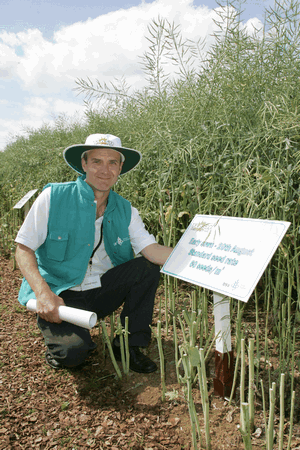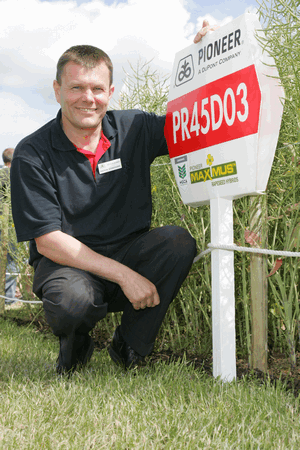Oilseed rape area set to grow

With most pundits at the show predicting a big upsurge in oilseed rape sowings this autumn, the message from many was “think oil” – be it in traditional varieties or the relatively new high oleic/low linoleic (HOLL) types.
Mineral oil was not the only shortage affecting growers. Supplies of vegetable oils were increasingly tight. “World stocks are at an all-time low,” said United Oilseeds’ Chris Baldwin.
“We think next year’s plantings here could be 670,000ha against the 600,000 or so in the ground now. That could give us our first-time ever 2m tonne crop.”
All agreed that recent price rises made varieties’ oil content increasingly valuable.
Forecasting a more conservative sowings lift of about 6%, Frontier’s Charlie Whitmarsh said: “We’ve got to encourage farmers to grow oil. The premiums are substantial – £24-28/t at present prices.”
On the likely area, Elsoms’ Ian Munnery was more cautious. “It will go up, but only about 5%, not by the 10-15% that some are saying. Rotations are too tight.”

Hybrids’ uniformity is a plus, says Mike Mann.
He believed some of the yield plateauing occurring on farms, despite breeding improvements, was due to volunteers of lower potential.
Most bullish was Pioneer’s Andy Stainthorpe on the basis that the wheat price had slipped. “We think 700,000ha is not impossible.”
But that level would be rotationally unsustainable, warned Grainfarmers’ Lee Bennett. The current season’s area had dropped 8-10%. “At the very least we expect a full recovery.”
Within that the area of HOLLs, though, only just over 1%, could double, he estimated.
David Thomas of McDonald’s Restaurants welcomed the arrival of such types in the drive to use healthier oils, like sunflower, for cooking. “It’s good news, as it means we can source more from the UK.”
ADM’s John Wegrzyn noted that the recent 100% switch to sunflower oil by a well-known crisp manufacturer had not been without side-effects. “It changed the flavour of the end product.”

Semi-dwarf varieties offer big fuel savings, says Andy Stainthorpe.
The risks, from volunteers and cross-pollination, of growing HOLL varieties (Arable 23 May) had been over-played, according to Grainfarmers’ Paul Taylor.
After three harvests, grown on contract with premiums to offset their currently yield penalties, there had been no failures from excess linoleic acid, even in rotations as close as one in four, he noted.
Monsanto’s David Leaper, who anticipated the firm’s Vistive varieties and covering 60,000ha within three years, agreed.
“Farmers are now saying it’s a risk worth taking, especially if they haven’t grown rape for four or five years.”
Although former sugar beet land was an ideal virgin land opening, the area was limited, he noted.
Initial cautious advice on separation distances from double-low types had been eased. “You can now grow them adjacent to double-lows, though we still say they need to be 50m away from high erucic varieties.”
A new rapid analysis test, allowing samples to be checked for oil quality within 24 hours, should give growers even more assurance, added Mr Leaper.
It gave those concerned that they might have a volunteer problem the chance to segregate combine output and have it tested before bulking or, if necessary, storing it separately, perhaps for crusher blending, he said.
Little interest in new hybrids on NIAB plots
The long-standing hybrid vs conventional varieties debate rumbled on, with Flash, a hybrid topping the Recommended List for gross output.
“Hybrids are the future,” said DSV’s Mike Mann. “Very few professional vegetable growers aren’t using hybrids because they get uniform crops,” he said.
But while 12 of the 16 candidate varieties for the next RL were hybrids, they had attracted little grower interest, noted NIAB’s Simon Kightley.
The most promising appeared to be Dimension, with Flash-type output. But for southern growers the conventional Castille remained a key variety.
“However, there’s good news for northern growers,” said Mr Kightley. Two of the newcomers, Cuillin and Emerson, were rated 9 for light leaf spot resistance and another three scored 8.
Given the new recently announced special HGCA RL category, there was guaranteed to be a semi-dwarf variety listed for 2009, noted Mr Stainthorpe. “Two are eligible. One is our PR45D03.”
The other was Dekalb’s DK Secure, which breeder Matthew Clarke described as “impossible to lodge”.
“The big advantage with them is the fuel savings at harvest” said Mr Stainthorpe.
Double-lows question mark
Harking back to when single-low varieties were ousted by double-lows on health grounds, Mr Mann said the fate of the former under EU rules would be “interesting” should HOLL types become the norm.

